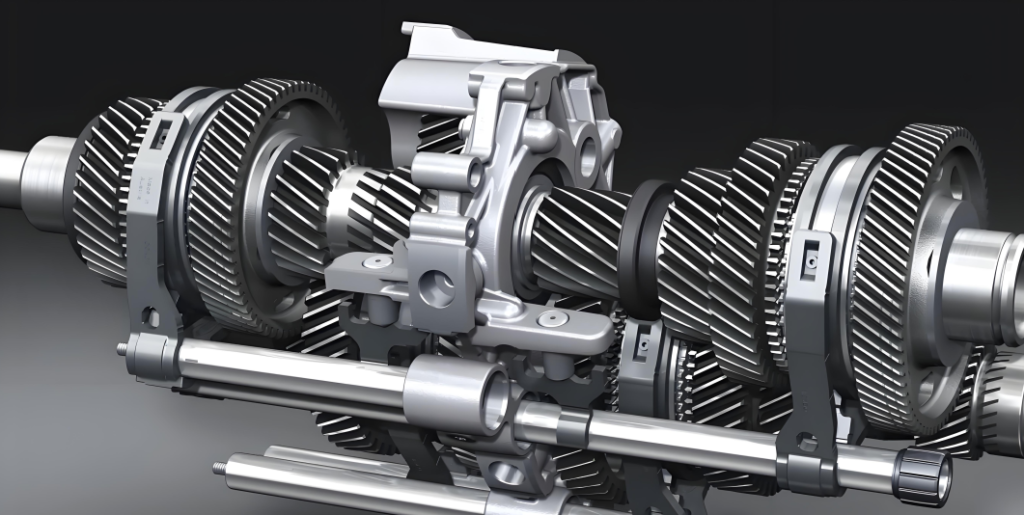How precision in every stage — design, manufacturing, assembly, and maintenance — defines the reliability and performance of gear systems.
1. What Is Gear Transmission Accuracy?
Gear transmission accuracy is more than just how precisely a single gear is machined.
It represents the overall system precision — how closely a gear pair’s actual motion matches its theoretical motion when transmitting power and motion.
In simple terms, high transmission accuracy means:
- The output shaft precisely mirrors the input shaft in displacement, speed, and acceleration, maintaining a constant gear ratio (i = Z₂/Z₁).
- The operation is smooth, quiet, and free from vibration or impact.
- Power is transmitted efficiently, with minimal energy loss.
When accuracy drops, issues quickly arise — motion errors, vibration, noise, shock loads, and overheating — all of which shorten gear life and reduce system efficiency.
To evaluate gear accuracy, engineers usually look at four key dimensions:
1.1. Motion Accuracy (Tolerance Group I)
- Definition: The maximum angular error per full gear revolution — reflecting low-frequency errors such as runout and pitch variation.
- Why it matters: Affects transmission ratio stability — critical for indexing, robotics, and precision positioning applications.
1.2. Running Smoothness (Tolerance Group II)
- Definition: The instantaneous change in transmission ratio within one tooth pitch — representing medium-frequency errors like profile deviation.
- Why it matters: Determines how smoothly and quietly a gear runs — especially important for high-speed transmissions.
1.3. Load Distribution Uniformity (Tolerance Group III)
- Definition: The consistency between the actual and ideal contact areas on the gear teeth.
- Why it matters: Ensures even stress distribution, longer life, and fewer failures such as pitting or scuffing.
1.4. Backlash
- Definition: The small clearance between non-working flanks of a gear pair. It’s not an error, but a necessary design allowance that must be tightly controlled.
- Why it matters:
- Too small → overheating, seizure, poor lubrication.
- Too large → noise, backlash, and positioning error.
These four parameters together define the complete picture of transmission accuracy.
According to ISO 1328 and GB/T 10095, gear accuracy is classified into
13 grades (0–12)
— Grade 0 being the highest.
The appropriate grade should always match the intended application and cost balance.
2. Designing for High Gear Accuracy
Precision begins at the design stage. Every detail — from geometry to material — affects the final performance.
2.1. Choosing the Right Accuracy Grade

2.2. Optimizing Gear Geometry
- Module & Tooth Number: Smaller module + more teeth → higher contact ratio → smoother operation.
- Pressure Angle (20° standard): Larger angle increases strength but also bearing load.
- Profile Shift (X-gearing): Prevents undercutting, adjusts center distance, and improves load capacity — a key design optimization.
- Microgeometry Modification: Fine-tuning through crown relief and tip relief helps compensate for deflection, thermal distortion, and misalignment — a must for silent, durable gears.
2.3. Material and Heat Treatment
- Materials: Choose based on load and environment — e.g., 20CrMnTi (carburized), 45# (quenched & tempered), 38CrMoAl (nitrided).
- Heat Treatment: Processes like carburizing, nitriding, or induction hardening increase hardness and wear resistance, but require post-process grinding to correct deformation.
2.4. System Stiffness and Structure
- Housing: Maintain high rigidity and precise bearing alignment.
- Shafts and Bearings: Use stiff shafts and high-precision, low-clearance bearings with proper preload.
3. How to Achieve and Maintain High Transmission Accuracy
Even the best design fails without proper manufacturing, assembly, and maintenance. Precision must be engineered, produced, and preserved.
3.1. Manufacturing Process (Core Stage)
- Gear Grinding: The top-level precision process (up to Grade 3 or better).
- Gear Honing: Improves surface finish and corrects small distortions.
- Gear Shaving: Efficient pre-heat-treatment finishing to reduce profile and lead errors.
- Precision Hobbing: High-accuracy hobbing can reach Grade 5–6.
- Heat Treatment: Control temperature and time to minimize deformation.
- Finishing: The final step that brings all tolerances into specification.
3.2. Inspection and Quality Feedback
- Offline Inspection: Gear measuring centers or CMMs record pitch, profile, lead, and runout for process correction.
- Inline Inspection: Probes measure key parameters directly on machines for real-time feedback — ensuring closed-loop precision control.
3.3. Assembly and Adjustment
- Clean environment: Dust-free assembly ensures flawless contact surfaces.
- Accurate alignment: Maintain shaft parallelism and center distance.
- Bearing preload: Apply correct preload for stability and longevity.
- Backlash adjustment: Use shims or eccentric sleeves for fine-tuning.
- Contact pattern check: Apply blue marking compound, rotate lightly, and verify contact area position and shape.
3.4. Operation and Maintenance
- Lubrication: Use clean, correct-grade oil with proper viscosity and flow.
- Load control: Avoid sudden shocks or overloads.
- Condition monitoring: Regularly check vibration, noise, and oil quality for early fault detection.
. Conclusion
Gear transmission accuracy is a full-chain discipline — it must be designed, manufactured, assembled, and maintained with precision in mind.
High accuracy is not achieved by machining alone — it’s the result of:
- Design excellence – through optimized geometry and profile correction.
- Manufacturing precision – via advanced grinding and honing processes.
- Assembly discipline – with careful alignment and inspection.
- Operational care – through lubrication and predictive maintenance.
Any weak link becomes the limiting factor for the entire system’s performance.
In today’s high-end manufacturing world, the pursuit of gear transmission accuracy is, in essence, the pursuit of reliability, efficiency, and ultimate mechanical performance.
Thank you for reading. We are looking forward to serving you with our exceptional gear solutions. #BeyondGears
Read More:


